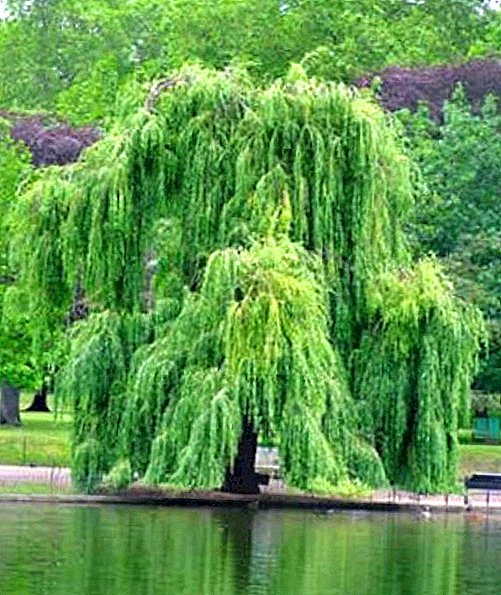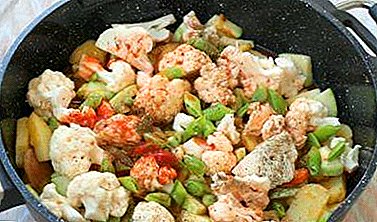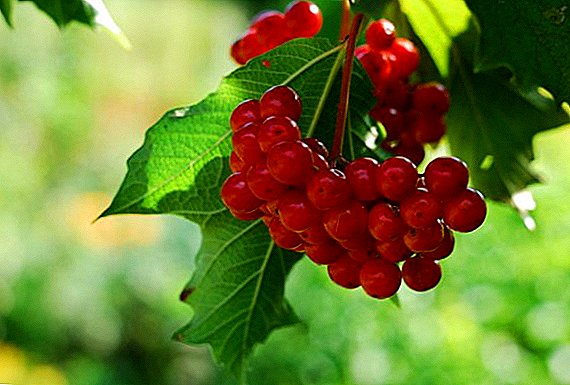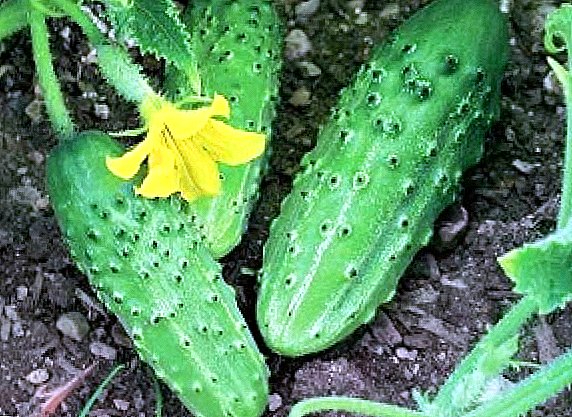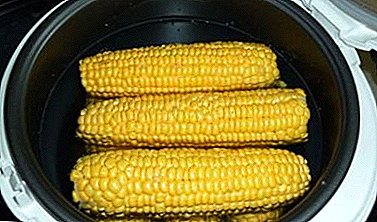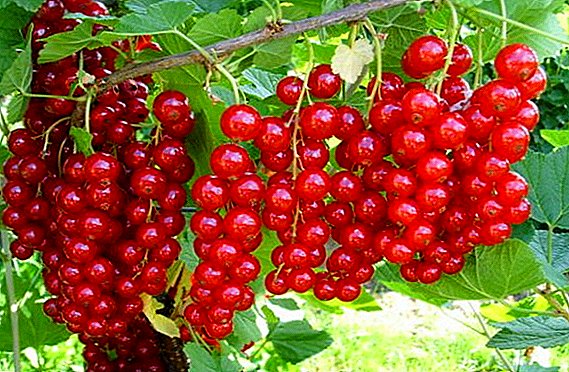 Currant bushes usually fit well into the landscape design of the suburban area, and all that is needed is to choose the right variety, which, in addition to its excellent taste, will also be characterized by an attractive appearance. One of these plants is the red currant variety "Sugar", about which we want to tell in this article.
Currant bushes usually fit well into the landscape design of the suburban area, and all that is needed is to choose the right variety, which, in addition to its excellent taste, will also be characterized by an attractive appearance. One of these plants is the red currant variety "Sugar", about which we want to tell in this article.
Description and characteristics
When describing the main characteristics of any variety of currants should be considered separately the features of fruits and bushes. If it seems to you that the data on the latter are not important, then this is not so: you need to know where and how to plant the seedlings so that they look good from the outside. 
Therefore, the description of currant "Sugar" we begin with the characteristics of the plant itself.
Shrub
This variety is represented by tall shrub plants that grow up to two meters in height. All branches are upright, slightly sprawling, with fruit buds up to 9-11 cm in length. The leaf plate is formed by five lobes, with serrated edges.
Familiarize yourself with the rules of planting and caring for red currants.
Buds on the shoots - brown, oval. When flowering on the bush is easy to see a lot of small yellow-green flowers. The length of fruit brushes can reach 9 cm and combine up to 15-20 berries.
Did you know? Currant is one of the few plants found on almost all continents (not found only in Australia and Antarctica). Today, scientists have more than 150 species of wild-growing shrubs.

Berries
Each red currant berry "Sugar" fully corresponds to its name. The fruits of the shrub are very sweet and pleasant to the taste, so they are perfect for both preservation and fresh consumption, you can even without departing from the bush.
All of them are rounded and covered with bright red skin. Under it is juicy pulp of the same color. The weight of one currant is in the range of 0.8-1 g, therefore, it is impossible to call the plucked fruit clusters very light.
Some features of the variety
Before you decide to get "Sugar" red currants on your site, you should carefully examine all the features and distinctive features of this plant, which is very important for obtaining a good harvest. 
Disease and Pest Resistance
With timely treatment of bushes from pests and diseases, there is every chance of achieving maximum fruiting from currants of this variety. In general, the plant has good resistance to them, but anthracnose can significantly spoil its appearance. Habitual garden pests often bypass the shrub side.
It will be useful for you to learn about common diseases and pests of currants, how to deal with red spots on currant leaves.
Drought resistance and winter hardiness
High resistance to adverse environmental factors is another advantage of the described variety. Currant bushes perfectly withstand sudden changes in temperature, without a significant impact on yield, so they can be planted in areas with a temperate climate, and in more severe regions.
Ripening and yield
One adult plant brings an average of 4 kg of crop per season, maintaining such figures for 20-25 years. If you regularly fertilize the soil and properly care for the bushes, then the number of plucked fruits will increase, but still the average will not exceed 7 kg. 
The ripening of berries is observed already in the beginning of July, due to which the variety is referred to as early ripe varieties.
Important! "Sugar" red currant can not be called completely self-fertile, because its level of self-pollination can vary between 30-35%. That is why, when growing a variety, it makes sense to plant other varieties of currants on the site, providing additional cross-pollination. The best pollinators here are the varieties "Natalie" and "Viksne."
Transportability
If you collect currant fruit in clusters, they will be able to maintain their appearance for a long time, even if they have to be transported for a long time. All berries have good keeping quality, so they do not need to be used immediately.
Direction
From the red "Sugar" currant, you can cook almost any billet, or use fresh berries.
Learn how you can prepare red currants for winter, how to make red currant jam and black currant jam, how to make homemade black currant wine, black currant tincture, which is useful for the body red currant.
A good solution is also to freeze the harvest, which in this case does not lose its beneficial properties. 
The only thing for which this variety is not particularly suitable - the preparation of currant jams, which require high rates of solidification.
How to choose seedlings when buying
For a rich and tasty harvest, the question of choosing seedlings should be approached with great responsibility.
In fact, the choice of currant bushes of the described variety is not much different from the purchase of plants of other varieties of red currants, and the main points that should be taken into account in the situation of choice are as follows:
- the root system of the proposed options should be well developed, and the individual roots - long and not dry;
- in their upper part, the plants should not have any mechanical damage to the green mass or signs of damage by diseases and pests (no dried parts or holes on the leaves);
- bark of seedlings can flake off a bit, but, in general, all the twigs should have a healthy appearance, without spots and tuberosities (the cut should be light and without spots);
- It is desirable that the height of the above-ground part of the “Sugar” currant be at least 40 cm.

To reduce the risk of buying low-quality seedlings, it is better to immediately contact a professional nursery, where they will definitely sell the selected variety and not give it away for another.
In addition, after buying plants in specialized places, one can hope for their successful long-term transportation, since often such seedlings are stored in the most optimal conditions for them.
Choosing a place
For the red currant, the best substrate will be sandy and light loamy soils, as areas with heavy clay or acidic soil will not allow the seedling to grow and develop normally.
It is also worthwhile to ignore the areas with close groundwater occurrence, giving preference to small earthen mounds and elevations where possible. 
As for the frivolity and illumination of the selected area, this should be a place with a lot of sunlight coming to the site for a long time. So you can protect plantations from defeat by powdery mildew.
In addition, it is desirable to provide good protection from shrill winds, for which it is better to plant seedlings near buildings or a fence.
Did you know? In the old days, currants were called "monastic berry", since for a long time this shrub was found only on the territory of monasteries. The first mentions of its cultivation in such territories date back to the XI century.
Time and landing scheme
Currant seedlings can be planted both in spring and autumn, but as for the variety "Sugar", it is preferable to focus on the second option. The optimal time for planting in this case will be the very beginning of September (not later), so that young plants will have time to take root well before winter.
Of course, before planting bushes, it is necessary to properly prepare the territory and mark the site: taking into account the compactness of the variety, 1.2-1.4 m can be left between bushes. 
The process of planting seedlings consists of the following steps:
- We dig a shallow hole in advance (approximately 35-40 cm) or arrange a whole trench (if it is planned to plant several plants).
- Leave a hole for about 7 days so that the soil settles well.
- At the bottom of the hole we place the fertilizer in the form of fertile soil mixed with rotted manure or compost. If the land in the area is sour, you have to deoxidize it with chalk, cement, or just ground eggshell.
- We spill the soil with water and place the seedling in it, while maintaining an angle of 45 degrees.
- We straighten the roots and sprinkle them with soil, but only so that the root neck is only 5 cm deep. Such a planting option will create optimal conditions for the development of additional roots and young shoots appearing from the buried buds.
- In the root zone of a planted plant, we trample down the soil and form a hole for irrigation around the trunk.
- Liberally water the planted plant while using three buckets of water at the same time (this way you can speed up the growth of new roots, especially if you add the Kornevina solution to the liquid).
- After planting, all shoots are pruned to one third of their length, so that currants show a good growth in the first year of life.

In the same way, we plant the rest of the bushes, observing the planting pattern (not less than 1.2 m between adjacent seedlings).
Important! When watering, try not to pour currants, as the stagnation of water at the rhizome will lead to its rapid decay and the plant will not take root.
Basics of seasonal care
Proper planting of the Sugar Currant variety is a good basis for obtaining a tasty and abundant crop of currant fruits. However, this is only the beginning on the path of growing shrubs. In order for him to get accustomed well, he will have to provide him with the most suitable conditions, taking into account all varietal needs.
Watering
The variety "Sugar" has a high level of moisture-loving, so the bush will thank for its generous harvest for regular and abundant watering. It is especially important to provide soil moisture during the formation and development of the fruit, since a lack of moisture will lead to shedding of the ovaries. 
When watering, it is important to pour water clearly under the root of the bush, so that it does not fall on the trunk or currant leaves. In severe drought, the bushes are watered 1 time in 10 days, using 5 buckets of water at a time (for one adult bush).
At a more humid time, with a large amount of precipitation, the regularity of the introduction of fluid is reduced to about 1 time in 20 days.
Important! Do not get too carried away with watering, especially if the "Sugar" currant is planted in the lowlands. Stagnant moisture at the root system is as undesirable as its lack.
Soil care
To ensure a good harvest will help and proper care of the soil, providing for the timely removal of weeds, loosening and mulching to preserve moisture. The first time all these activities are carried out in the spring, well flooding the ground under the bushes with the help of a rake. 
You can also cover the substrate with humus and compost, which will inhibit the growth of weeds and preserve the moisture of the substrate. If you do not want to mulch the earth in a circle, then it is advisable to loosen after each irrigation, saturating the substrate with oxygen and at the same time ridding it of weeds.
Top dressing
In the first years after planting, sugar currant can be fertilized with a solution of nitroammofoski. On average, one bush spends a matchbox of a substance previously diluted in a bucket of water. Thus, it is possible to accelerate the growth of shrub shoots and form a strong and powerful plant.
A good option for fertilizer will be nitrogenous compounds - urea or ammonium nitrate. On average, per 1 square. m accounts for about 10 g of these substances. 
Pruning
An adult bush of currant "Sugar" consists of 15-20 large shoots, but in order to maintain just such a number of twigs, every spring, weak shoots will have to be pruned.
It is also important to pay attention to their location: they must grow in different directions. Before hibernation, you can cut out all diseased and dried shoots, thereby performing sanitary pruning.
Learn how to properly trim the currants.
Winter cold protection
When growing "Sugar" currants in areas with a temperate climate, the plant can not be covered at all for the winter, as even in severe frosts it perezimuet well. In the northern regions, after trimming the bushes, they can be prikopat or cover agrofiber, wrapping each escape separately.
Of course, this procedure will take some time, but the result is worth it. 
Important! Polyethylene cannot be used to cover red currants: all branches must have free access to the air.
The advantages and disadvantages of the variety
Variety of red currant "Sugar" has many advantages, however, and the disadvantages should not be forgotten. Consider each group of characteristics more closely.
The advantages of the described plants are as follows:
- all fruits have good dessert properties;
- bushes tolerate frosts and, more often, do not need additional shelter;
- the plant can be an excellent decorative element on the site, especially if you plant the bushes along the paths;
- Red currant "Sugar" refers to the early ripe varieties, so you can enjoy the berries from late June until autumn;
- all bushes are undemanding in their care, so when they are grown you can do with standard agrotechnical techniques (regular watering, loosening and mulching);
- the variety has a rather long fruiting period, even old branches can bear fruit for 25 years;
- Harvest can be used for a variety of purposes: both for making jams, compotes and tinctures, as well as for fresh consumption or freezing (all nutrients are preserved almost in full);
- Of the possible diseases, the described red currant is only susceptible to anthracnose, and the remaining ailments usually bypass it;
- frustrated fruits tolerate transportation and have good product data.

As for the shortcomings of growing this particular variety, they are much smaller, and among the main ones there are:
- mediocre size of the fruit;
- low level of self-pollination (about 30%);
- small crop data (at best - 7 kg from a bush).
If you plan to grow currants in the country for personal use, then the variety "Sugar" definitely deserves your attention. With good care, the harvest will be enough for the family, especially since with small physical costs you can get a lot of tasty fruits.
Feedback from network users




